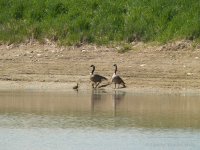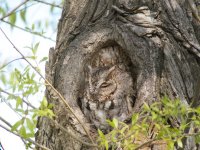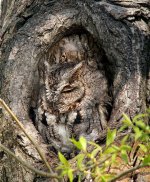BirdingDoc
BirdingDoc
I hope that someone can help me get sharper images with a new Kowa 883 (88 mm angled) spotting scope and a new Canon PowerShot S100 camera. I have attached a sample image (Canada Geese and goslings) which is a JPEG version of a typical RAW image, with no sharpening or other processing.
I have tried a variety of settings, with the best being an exposure time of 1/500 (or faster) with the smallest aperture (f/8.0). The ISO on this image is 250; even with an ISO of 100, the images are still not terrific.
I am using manual focus, and shooting a series of three images which are bracketed by variations in focus. To take a picture, I first focus the Kowa, and then do a manual focus of the PowerShot. On the PowerShot's viewing screen, the subject appears to be in good focus. However, the captured image isn't terrific. In each series of three shots, the bracketing of the focus does not appear to help, as all three images are of similar quality.
I have set up the PowerShot on Kowa's camera fixture, which is rock solid. It allows for three different positions for the camera, as it relates to the distance from the scope. I am using the middle position, such that I don't have to extend the lens (zoom) very much. I cannot install the camera in the closest position to the scope, as the lens fouls the scope, and when I install it in the furthest position, I have to zoom more and get a worse image.
I am quite certain that I have the camera and scope properly aligned (my career was in microscopy, so I am obsessive about optical setups).
Suggestion? Thanks for your help.
I have tried a variety of settings, with the best being an exposure time of 1/500 (or faster) with the smallest aperture (f/8.0). The ISO on this image is 250; even with an ISO of 100, the images are still not terrific.
I am using manual focus, and shooting a series of three images which are bracketed by variations in focus. To take a picture, I first focus the Kowa, and then do a manual focus of the PowerShot. On the PowerShot's viewing screen, the subject appears to be in good focus. However, the captured image isn't terrific. In each series of three shots, the bracketing of the focus does not appear to help, as all three images are of similar quality.
I have set up the PowerShot on Kowa's camera fixture, which is rock solid. It allows for three different positions for the camera, as it relates to the distance from the scope. I am using the middle position, such that I don't have to extend the lens (zoom) very much. I cannot install the camera in the closest position to the scope, as the lens fouls the scope, and when I install it in the furthest position, I have to zoom more and get a worse image.
I am quite certain that I have the camera and scope properly aligned (my career was in microscopy, so I am obsessive about optical setups).
Suggestion? Thanks for your help.
Attachments
Last edited:






